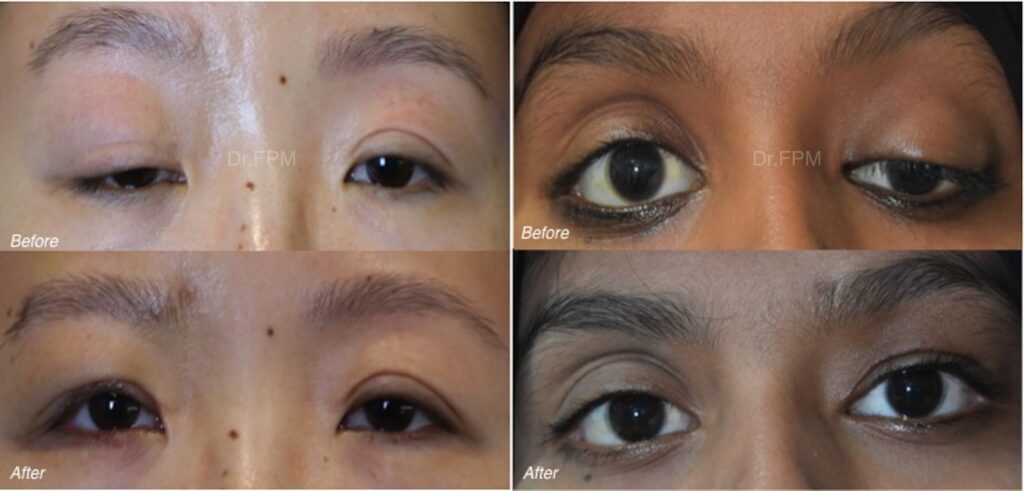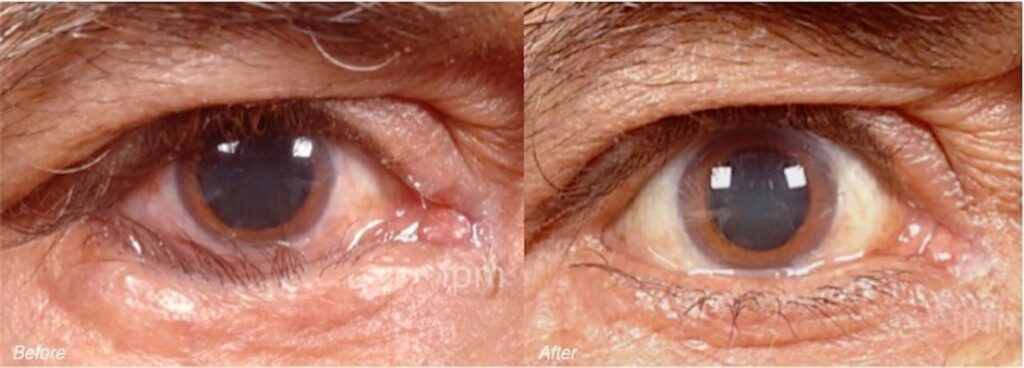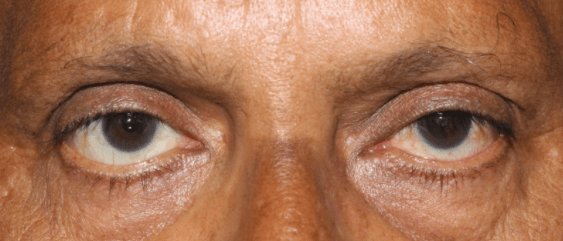Oculoplasty, Orbit and Aesthetics
It provides cutting edge treatment that repairs congenital and acquired defects of eyelids, socket, orbit, tear ducts and face. Rejuvenating the eyes and face aiming to restore natural appearance and, improve cosmesis. Our service is also dedicated to reconstruction of damaged eye structures due to trauma and disease.
Droopy eyelids
Drooping of the upper eyelids, otherwise called ptosis, may be congenital or acquired. Mostly due to weakness or disinsertion of the muscle that lifts the eyelid. If it is seen at birth it can be associated with maldeveloped muscle with very poor strength presenting from birth.
In children ptosis warrants early correction, to prevent lazy eye (visual deprivation amblyopia). Rarely it can be associated with syndromes that can have other facial defects as well. Surgical correction of blepharoptosis depends on the type and strength of the muscles that has to be assessed pre-operatively. We specialize in no scar, minimal access technique.




Blepharoplasty
Blepharoplasty also known as eye bag removal and/or removal of excess loose skin of eyelids has a dramatic effect and maintains ageless appearance of face. It is a cosmetic procedure performed using radiofrequency device with excellent outcome. It can be done on the upper lid, lower lid or both.

Entropion
Inward turning of the eyelid margin is called entropion. Most commonly seen in elderly. It is caused due to abnormality in the eyelid retractors and often due to scarring of the conjunctiva secondary to trauma (chemical, thermal and mechanical) infection, inflammation in diseases like Steven-Johnson syndrome. This may lead to associated inturning of the eyelashes that is traumatic to cornea and reduced vision. Surgical correction aims at restoring the position of the lid- margin and eyelashes. There are various surgical techniques and it is very essential to choose the method with less chance of recurrence. Mucous membrane grafting is used in severe cases.


Epiblepharon
It is a congenital eyelid anomaly presenting with extra fold of skin in the lower eyelid that causes the eyelashes to tilt inwards, pushing them against the globe. Most common among Asian children and some cases may resolve with facial structural changes as the child grows. However, it can cause corneal injury due to frequent rubbing of lashes against the surface of the cornea. The extra fold of skin can also cause astigmatism. Surgical correction and intervention is advised in the presence of lashes touching the cornea.

Ectropion
Outward turning of the eyelid margin is ectropion. It is most commonly due to laxity of the eyelid, secondary to involutional changes of ocular structures in older individuals. Ectropion can also be due to scarring of the eyelid skin after trauma or injury, paralysis of facial muscles and any eyelid mass pulling the lids down. Rarely it can be congenital. Surgical correction involves reducing the laxity of the lids and correcting the skin traction as in scarring. Surgical methods depend on the cause and vary from simple tightening of lids to skin grafting. Accurate clinical assessment, and choosing the appropriate technique renders excellent success.

Lagophthalmos
It is the inability to close the eyelids due to either paralysis of the facial muscles or due to scarring of the eyelid skin. This can lead to exposure of the eye, dryness and even ulcer in the eye. Main aim of surgery is to prevent damage to cornea with optimal cosmesis. It can also be corrected non-surgically.

Eyelid Reconstruction
Reconstruction of eyelid is performed for any defect in the eyelid. It can be due to lid laceration and injury after trauma, defect in the eyelid after tumor removal and even congenital defects of the eyelid. Surgical correction varies from simple closure of smaller defects to creation of flaps to cover the defects, aiming to preserve the natural appearance.

Facial trauma and fracture
Trauma to the eye and face can be only soft tissue and/or involving the bone of the orbit leading to disfigurement and difficulty in vision. Apart from the eyelid and periocular reconstruction, fractured bones can traumatize the eye muscles leading to double vision and sinking of the eye due to increased space due to displacement of the bone. This may require timely, accurate intervention to prevent further damage and restore normal vision. There are various materials available to cover the defect, and should be chosen wisely for good outcome.

Thyroid eye (Graves) disease
It is the most common cause of forward protrusion of eyeball in adults. It naturally progresses from an active stage to an inactive stage. There can be associated widening of the eyelid giving a scary appearance. Most often the main concern is cosmesis, but occasionally severe disease can be vision threatening due to compression of optic nerve and, may also lead to exposure of cornea leading to damage and ulceration. Immediate medical attention should be seeked in such scenario. Cosmetic correction of abnormal protrusion is done by minimally invasive key-hole orbital decompression and eyelid surgery.
Bulgy eyeball with widened eyelids can be a manifestation of thyroid disease.

Watery Eyes
Blockage in the tearduct is one of the causes of watering in the eye. It may be present at birth that resolves with regular massage, otherwise requiring intervention to clear the passage. In adults it starts as watering, progressing to discharge and infection. Secondary causes of tearduct obstruction are trauma, tumor and diseases of the nose. Surgically, an alternate route is made to drain the tears into the nose. It can be achieved by a procedure externally through the skin or endonasally. Alternate treatments are available depending on the site of the block.
Blockage in the tearduct leading to infection.
External drainage surgery performed in both eyes with minimal scarring.


Socket Reconstruction
Eyeball may have to be removed due to various reasons, including tumor, infection, pain in the blind eye and cosmetically disfigured eye. Two types of surgeries are performed.
- Enucleation involves removal of the eyeball.•
- Evisceration involves the removal of the contents of eyeball, leaving the ocular coats and muscles intact. The lost volume is replaced by placing an artificial implant in the empty socket. Remaining volume is regained by the fitting of the cosmetically carved and painted artificial eye. The artificial eye is custom-made by matching with the other eye.
- •Exenteration is yet another procedure done in the presence of large tumors of the eye where the eye and the orbital tissue is removed. Lid-sparing exenteration allows early healing and better fitting of prosthesis.

Contracted Socket
This is a condition where the socket cannot hold the artificial eye in place. If an implant has not been placed at the time of the initial surgery, socket tends to contract. Reconstruction of contracted socket is done to achieve adequate cosmesis, involves formation of deep space in the socket by restoring volume and surface.

